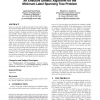Free Online Productivity Tools
i2Speak
i2Symbol
i2OCR
iTex2Img
iWeb2Print
iWeb2Shot
i2Type
iPdf2Split
iPdf2Merge
i2Bopomofo
i2Arabic
i2Style
i2Image
i2PDF
iLatex2Rtf
Sci2ools
116
Voted
GECCO
2006
Springer
2006
Springer
An effective genetic algorithm for the minimum-label spanning tree problem
Given a connected, undirected graph G with labeled edges, the minimum-label spanning tree problem seeks a spanning tree on G to whose edges are attached the smallest possible number of labels. A greedy heuristic for this NP-hard problem greedily chooses labels so as to reduce the number of components in the subgraphs they induce as quickly as possible. A genetic algorithm for the problem encodes candidate solutions as permutations of the labels; an initial segment of such a chromosome lists the labels that appear on the edges in the chromosome's tree. Three versions of the GA apply generic or heuristic crossover and mutation operators and a local search step. In tests on 27 randomly-generated instances of the minimum-label spanning tree problem, versions of the GA that apply generic operators, with and without the local search step, perform less well than the greedy heuristic, but a version that applies the local search step and operators tailored to the problem returns solutions...
Related Content
| Added | 23 Aug 2010 |
| Updated | 23 Aug 2010 |
| Type | Conference |
| Year | 2006 |
| Where | GECCO |
| Authors | Jeremiah Nummela, Bryant A. Julstrom |
Comments (0)

